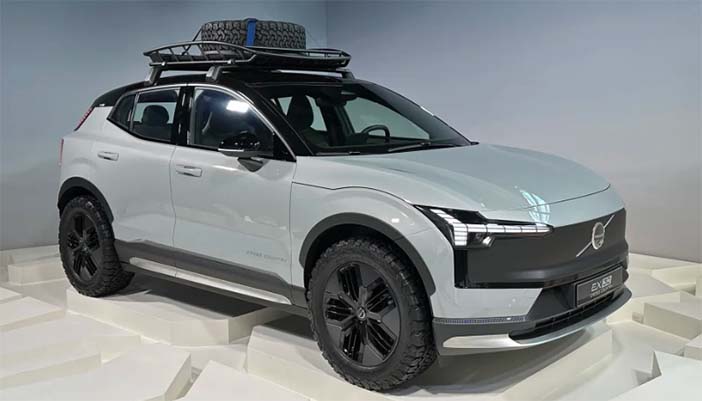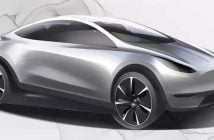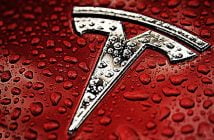+++ LORDSTOWN MOTORS said it plans to take legal action against investor Foxconn to ensure that the Taiwanese contract manufacturer completes a planned purchase of nearly 10% of the electric vehicle startup’s shares. The company and its EV peers have been struggling as access to capital tightens from rising interest rates and economic uncertainty. The cash-strapped EV maker had warned earlier it might be forced to file for bankruptcy, citing uncertainty over a $170 million investment deal with Foxconn through which the Taiwanese company would hold a near-20% stake in the money-losing U.S. firm. It currently holds a little over 8% in the company. Foxconn has since invested $52.7 million and is balking at purchasing additional shares, citing a breach of their agreement, Lordstown said. On Friday, the U.S. company, named after the town in Ohio where it is based, said in a filing it believed Foxconn was unlikely to complete the promised purchase, citing a letter the contract manufacturer sent Lordstown earlier this month, in which the Taiwanese company did not acknowledge the subsequent common closing. “The company believes that Foxconn’s various breaches of the investment agreement and pattern of bad faith have caused material and irreparable harm to the company”, Lordstown added in the filing. Lordstown, whose shares has tumbled more than 80% this year, also said in May it might have to stop making the Endurance pickup truck in the near future unless it finds a partner. +++
+++ The California Department of Motor Vehicles on Thursday approved MERCEDES-BENZ ‘ automated driving system on designated highways under certain conditions without the active control of a driver. California is one of Tesla’s largest markets, accounting for 16% of the carmaker’s global deliveries last year. But the German carmaker beat Tesla to become the first carmaker to receive authorization to sell or lease cars with an automated driving system to the public in California. The approval was granted to Level 3 Mercedes-Benz “Drive Pilot” system that allows a driver to legally take their hands off the wheel but must be available to resume control in need. The Drive Pilot system can only operate on highways during daylight at speeds not exceeding 65 km per hour, the DMV said. Mercedes-Benz said in a statement it will make the automated driving system available in the U.S. market as an option for its model year 2024 S-Class and EQS Sedan vehicles. The first deliveries for the respective S-Class and EQS Sedan models are expected later this year. Other systems currently on public roads such as Tesla’s Autopilot or General Motors’ Super Cruise are classified SAE Level 2, which handle some driving tasks but require drivers to pay attention at all times. Tesla calls its level 2 driving assistant system “Full Self-Driving” and says a driver must constantly supervise the feature and intervene as needed to maintain a safe operation. The permit grants Mercedes-Benz permission to offer Drive Pilot on California highways in the Bay Area, Central Valley, Los Angeles, Sacramento and San Diego and on interstate highway connecting Southern California to Nevada. Earlier this year, Mercedes-Benz also received an approval to deploy advanced automated driving systems on Nevada’s roads. +++
+++ Frequent interviews with PORSCHE boss Oliver Blume include a question as to when we’ll see another Porsche hypercar. He once answered the queries with some version of “not until the middle of the decade at the earliest least”. His most recent answer, from April of this year, pushed that back toward the end of the decade; Blume and R&D chief Michael Steiner say current battery technology isn’t prepared to satisfy the demands a Porsche hypercar would make on it, so everyone will need to wait for next-generation cells due in 4 or 5 years. So the car you see here, the Porsche Mission X concept, isn’t the next Porsche hypercar and at the moment isn’t planned for sale. However, the battery-electric 2-seater with the “ultra high-performance” powertrain is full of indicators about what might be down the road. Dressed a specially created Rocket Metallic with satin carbon fiber accents, dimensions 450 centimeter in length and 200 centimeter in width, the concept fits into same rough footprint as the 2003 Carrera GT and 2013 918 Spyder. The 20 inch wheels in front and 21 inchers in back eat up nearly half the 2-seater’s 120 centimeter height. Since this concept counts as one of the brand’s 75th birthday presents to itself, historic cues mix with modern ones. The illuminated DRLs in the photos rework the four-point signature seen on the automaker’s road cars. At the same time, the DRLs and the 4 led main beams buried in the lattice support structure call back to the stacked double headlights that sat inches off the ground on Le Mans racers like the 906 and 908. Passengers enter through doors that swing up and forward like those on top-class Le Mans prototypes going back decades, then sit under a glass dome built around a skeleton of carbon fiber reinforced plastic. And the Mission X marks the debut of Porsche’s new crest. It’s all modern in back. A horizontal lattice supports thin, ornate LED taillights that bracket floating, illuminated Porsche logotype. When charging, the “E” pulses in white. The cabin begs even onlookers to hit top speed. The carbon-backed seats and their 6-point harnesses appear largely built into the tub. Both feature Andalusia Brown lowers, the driver’s throne additionally signified by the Kalahari Gray upper. There are 4 paddles behind the steering yoke; I’m not sure what they control other than the obvious guess of regen braking. The ornate stopwatch in front of the passenger is a removable unit clipped into a bayonet system on the instrument panel, created by Porsche Design. At the track, the stopwatch could be used in conjunction with the multiple built-in cameras. One imagines other accessories, like a screen, could go here when not on the track. Porsche calls it a “reinterpretation of a hypercar,” but we don’t know enough about the Mission X yet to understand what that means. Drivetrain and output specs weren’t included with the reveal. We’ve been told the battery sits behind the cockpit in a way that mimics mid-engined dynamics, the setup called “e-core”. The automaker said that were the street-legal coupe to get a production run, it would aim to “be the fastest road-legal vehicle around the Nürburgring Nordschleife; have a power-to-weight ratio of roughly 1 hp per 1 kilo; achieve downforce values that are well in excess of those delivered by the current 911 GT3 RS; offer significantly improved charging performance with its 900 volt system architecture and charge roughly twice as quickly as the current Porsche frontrunner, the Taycan Turbo S”. Starting from the top, the Mission X has the Mercedes-AMG One in its sights, the other Stuttgart hypercar maker owning the Nordschleife record with a time of 6:35.18. That’s about 22 seconds faster than the 918 Spyder ran the lap, the 918 the first production car to break the 7-minute barrier. The 918 Spyder weighed about 1.650 kilograms. Given the weight of an electric hypercar (the Rimac Nevera weighs about 2.300 kg), I might think a Mission X comes in at 1.700 hp on the extreme low end to as much as 2.300 hp. The GT3 RS produces as much as 860 kg of downforce but uses a giant wing and other aero addenda to do it, meaning the undisturbed Mission X concept’s glasshouse and upper surfaces are hiding an underbody full of chicanery. And the Taycan Turbo S maxes out at 270 kilowatt charging to go from 5% to 80% state of charge in a little more than 20 minutes. As for the chances of a version you can buy, Porsche says Mission X “production to be decided in due time”. I have no doubt the phones at HQ have been ringing with “name-your-price” offers all day. I don’t see why Porsche would miss the chance to celebrate its birthday with a cool new concept, some treats for its best clients, some icons for posterity and a stupendous haul of loot. +++
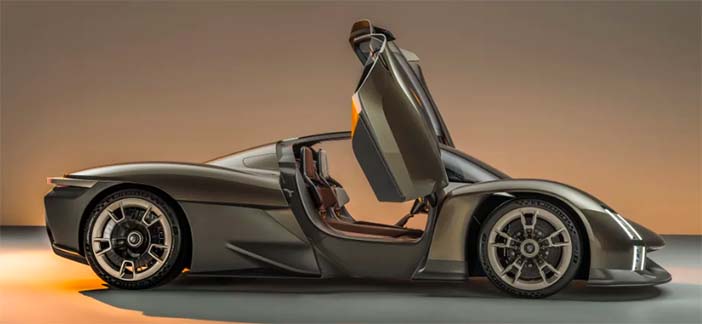
+++ ROLLS-ROYCE released its first series-produced electric vehicle, the Spectre, in 2022, and the brand plans to launch additional battery-powered models in the coming years. It’s not closing the door to other powertrains, however, and it’s notably open to experimenting with hydrogen fuel cells. “Why not? I would say so when the time is right for us, and when the technology is so much advanced, that it is definitely something we would pursue as Rolls-Royce. Why not? We might exit batteries, and we might enter into fuel cells”, company boss Torsten Müller-Ötvös told. He stopped short of revealing whether engineers are currently testing hydrogen fuel cell-powered prototypes. It’s too early to tell whether Rolls-Royce would develop a hydrogen fuel cell on its own or whether it would source some of the drivetrain’s parts from parent company BMW, which has dabbled in this technology for decades. BMW notably began building an X5-based, hydrogen-powered prototype called iX5 in 2023 and it plans to ultimately funnel the feedback it gathers by testing the model into a production car. Müller-Ötvös has already ruled out building a car powered by a hydrogen-burning engine, however. “I think a hydrogen combustion engine is nothing I would in any way look into, because that was tested already years ago. This is not the most efficient way to use hydrogen. If hydrogen will be used in the future, then it’s fuel cells. And fuel cells are nothing different from a battery. It is just how you get the energy”, he told, referring to the hydrogen-burning 7 Series prototype tested by BMW in the 2000s. Rolls-Royce, like nearly every brand looking at hydrogen technology, warns that the infrastructure needs to improve before the fuel cell can merge into the mainstream. “You can’t obviously have hydrogen charging at home, whereas with electric cars, you have one big advantage, and all of our clients have big garages. There is lots of space at home and there is lots of space in office buildings to install charging”, the CEO said. As it stands, Rolls-Royce wants to sell only electric cars by the end of 2030, and it hasn’t announced plans to launch a series-produced hydrogen-electric model. It’s not unreasonable to assume that this outlook could change during the second half of the 2020s, however. BMW boss Oliver Zipse told that he predicts the industry will experience “a scarcity of raw materials needed to build electric cars if we continue to ramp up production” in 2027 and 2028, and that hydrogen could be a solution because the drivetrain requires a smaller battery pack. +++
+++ Tesla owners probably won’t be very happy that the EV maker is opening up its SUPERCHARGER network to outsiders. In May, Ford and Tesla announced a partnership allowing the Detroit automaker to use Tesla chargers starting in 2024. And last week, it was also announced that GM would gain access next year. While the partnership among rivals benefits Tesla from a revenue standpoint, it may cause some tension with its car owners. “So nothing is going to irritate a Tesla owner more than lining up behind a bunch of vehicles from Ford and General Motors”, said Craig Irwin, a senior research analyst at Roth Capital Partners. “I mean, imagine a big Hummer. It’s going to take a charger for an hour in front of you while you’ve got to go and do your errands and get your groceries. It’s not going to be something where people are going to say, ‘Oh great, that car has General Motors badge on it. But the charger says Tesla. I paid for that. What’s up with that?’ “. Irwin isn’t the only one who is worried about how these charging deals may affect its relationship with Tesla’s customers. Gene Munster, managing partner at Deepwater Asset Management, said that it’s possible Tesla owners will be frustrated by the change, as it could lead to longer wait times. Tesla’s Supercharger network is comprised of some 7.000 locations in North America, according to the Department of Energy. It has long been considered one of the company’s most notable advantages over the competition. This is because range anxiety is a top concern among consumers shopping for an EV. Tesla knew this, so it started building out its network about a decade ago to address the issue. Earlier this year after Tesla first said it intended to open up to the public, some owners told Insider they were upset by the move because exclusive access to the Supercharging network was part of the reason they bought a Tesla. But some said that it was a good move that would help accelerate EV adoption, while also putting pressure on other rival charging companies to improve their service. But allowing other car owners to use the network may also eventually benefit Tesla owners, too. Tesla could use the revenue generated by new customers to invest in expanding its charging network, meaning more access for everyone, said Cathie Wood, Ark Invest CEO. “What’s interesting about this is it does help Tesla underwrite the charging station expense”, Wood, who has a $2.000 price target on Tesla stock by 2027, said. “Because if you look at Tesla sales they are highly concentrated on the coasts. Now, it’s going to make a lot more sense for Tesla to roll out charging stations that much faster throughout the country”. +++
+++ Remember the first time we saw the TESLA CYBERTRUCK ? No? If you don’t, it’s probably because the as-of-yet-unreleased EV was revealed in late 2019, almost 4 years ago. The event was notable, not just for the wild, futuristic vehicle shown on stage, but for the major blooper that occurred when Tesla CEO Elon Musk tried to demonstrate its “armored glass” breaking the window on stage. As it turns out, that was just one of several early issues the Tesla engineering team discovered with the alpha-level prototype. A recently leaked document sheds some light on why it’s been almost 4 years since the truck’s reveal and pulls back the curtain on the complex engineering process behind its development. The company struggled to solve issues with body sealing and leaks, noise, handling and braking, and suspension. While those are common issues with any new model, industry insiders expressed surprise at how much effort and time it took to solve them. Some of the problems stemmed from the truck’s design, which presented unique challenges with body sealing and noise. Getting a good seal with traditional automotive shapes is hard enough, and the sharp, geometric Cybertruck made the process even more challenging. The document also outlines other issues, such as “high head-toss accelerations”, “structural shake” and “excessive mid-speed abruptness and chop”. Some of the more advanced features promised for the truck also presented early problems, such as the “strafe mode” which functions like the crab walk feature in the GMC Hummer EV. Even with these issues and others, Tesla promises it’s on track to release the truck by the end of this year, though volume production won’t start until sometime in 2024. Once it does land, the Cybertruck’s shape may continue to cause issues for its widespread adoption, as some point to potential difficulties passing safety regulations in Europe and elsewhere. Stainless steel is a complicated metal to work with and does not flex like traditional steel, so the truck’s crumple zones and other features may be compromised to meet the design. +++
+++ Can an automobile be considered a “future classic” before it reaches a dealer’s showroom floor? If it’s a “limited-run special edition” VOLKSWAGEN GOLF R 333 (and the dealer’s in Germany), then absolutely. Never mind that this particular Golf is by far the most expensive configuration of that model: the entire allotment of 333 cars, bound exclusively for Germany, sold out in 8 minutes. Of course, “sell out” in car dealer-speak is only an optimistic notion until cold cash (or the equivalent) changes hands. And let’s not dismiss the temptation of dealer markups. The car is due to go on sale in October. VW’s head of product communications Stefan Voswinkel took to LinkedIn a few days ago to announce the Golf R 333 selling out. “Okay, that was fast, even for a Golf R. The special model Golf R 333 was sold out after 8 (!) minutes”, he said. He didn’t say if VW’s press team deserved some kudos, but he probably didn’t need to. To date, the car’s only been seen in press previews and photos and in flattering stories on websites. Skeptical sports car mavens may suggest that 333 money would also obtain a Porsche 718 Cayman S. An Audi RS3 would cost significantly less. But “333” is an attractive number. At any rate, the special hot hatch, essentially a follow-up to the Golf R 20 Years Edition, has its turbocharged engine dialed to 333 horsepower and 420 Nm. It’s a tweaked version of VW’s workhorse 2.0 TSI four-cylinder petrol engine. Other specs indicate a 0-to-100-kph time of 4.6 seconds and a top speed of 270 kph. +++
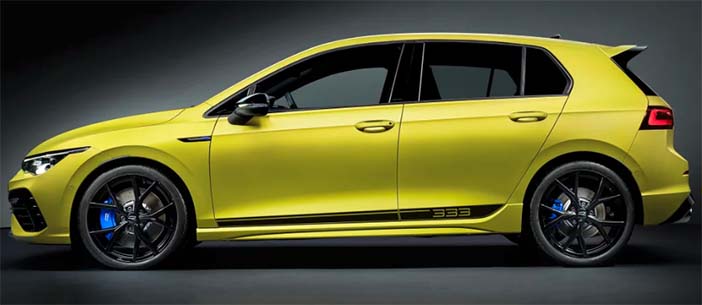
+++ Appealing as the new VOLVO EX30 is in standard guise, it’s the upcoming Cross Country version that’s got my interest piqued. Volvo hasn’t introduced a new Cross Country model since the V60 was revealed in 2018, and the company has never applied this treatment to one of its SUVs (though we may never forget the S60 Cross Country sedan). “I really like the idea of having the Cross Country as part of the brand”, Volvo boss Jim Rowan said in an interview. Rowan declined to comment on Volvo’s plans to expand the Cross Country lineup further, but did talk about why a car with an outdoorsy vibe totally makes sense as an EV. “When you have a fully electric car, you open that tailgate, you stick a tent on the back of it and you use the HVAC system to heat or cool the car”, Rowan said. “You can run a small fridge off of it, you can charge an electric bike off of it. You can do a whole bunch of stuff that you could never do because you’ve now got this massive electric power source that you never had”. Of course, that’s all dependent on your ability to charge your car at or near your desired remote getaway spot. EV chargers are still a rarity at many national parks, though that’s quickly changing. In this wide-ranging interview, Rowan also touched on Volvo’s progress with installing lidar systems in its vehicles; something first seen on the larger EX90 but absent on the EX30. “It’s 2 different platforms”, Rowan pointed out. “At one point in time we wondered whether we could get lidar actually into the EX90”. And when it came to designing the EX30, “It was more a case of ‘can we get this car out on time. It was on a different platform which never really allowed us the option”. Later in the conversation, Rowan discussed Volvo’s plans to offer over-the-air updates in the EX30. This gives Volvo the ability to perform lots of future upgrades, but it also opens the door for pay-to-play feature subscription fees; something Rowan said the company has no plans to pursue. “Personally, I don’t think it plays with the brand”, Rowan said. “We’re seen as a bit of the honest broker. I think we want to maintain that”. Rowan said EX30 customers will see “a whole plethora” of different updates, but “some will just be tidy-up” updates to make the vehicle’s software perform better. “I don’t subscribe that there’s a massive business model to keep charging your customer more for software updates unless it’s meaningful”, Rowan said. “If you want to have a fine-tuned performance engine and we can do that through software, that’s gonna be an upgrade. Heated seats? Probably not”. The EX30 is available to pre-order now. The Cross Country is expected to follow next year, with production estimated to start in late 2024. +++
